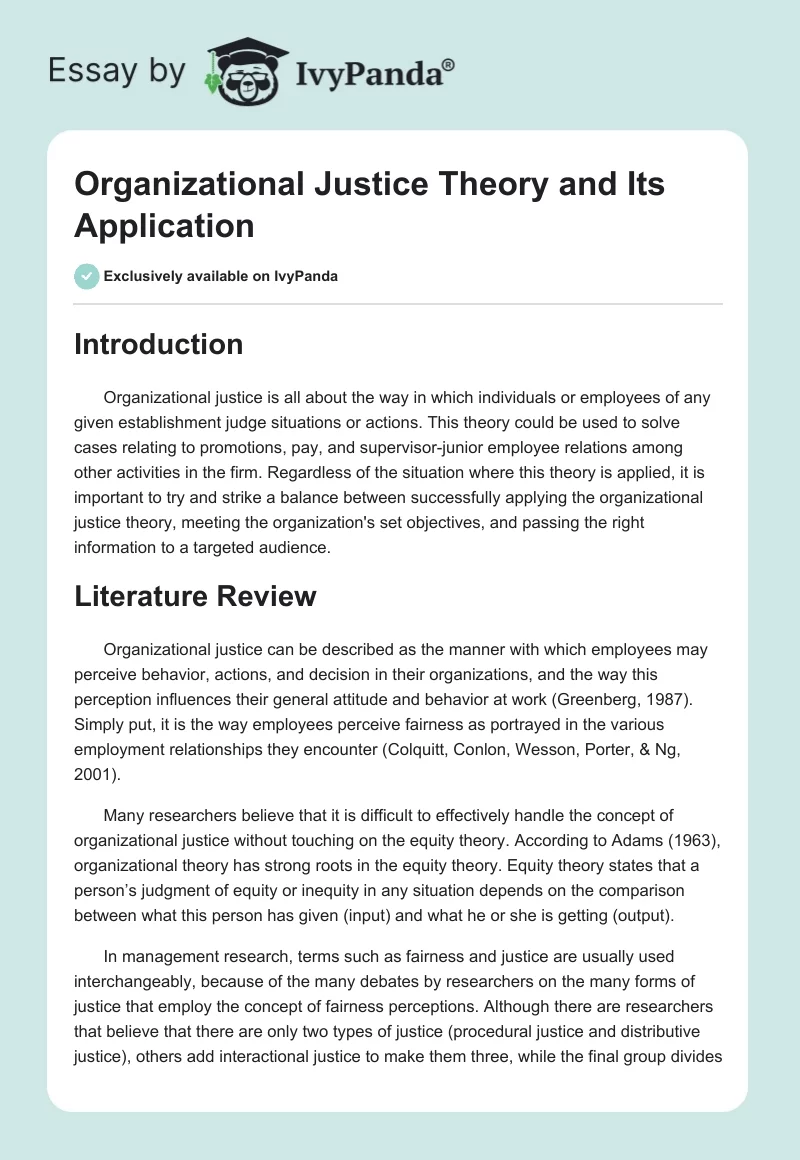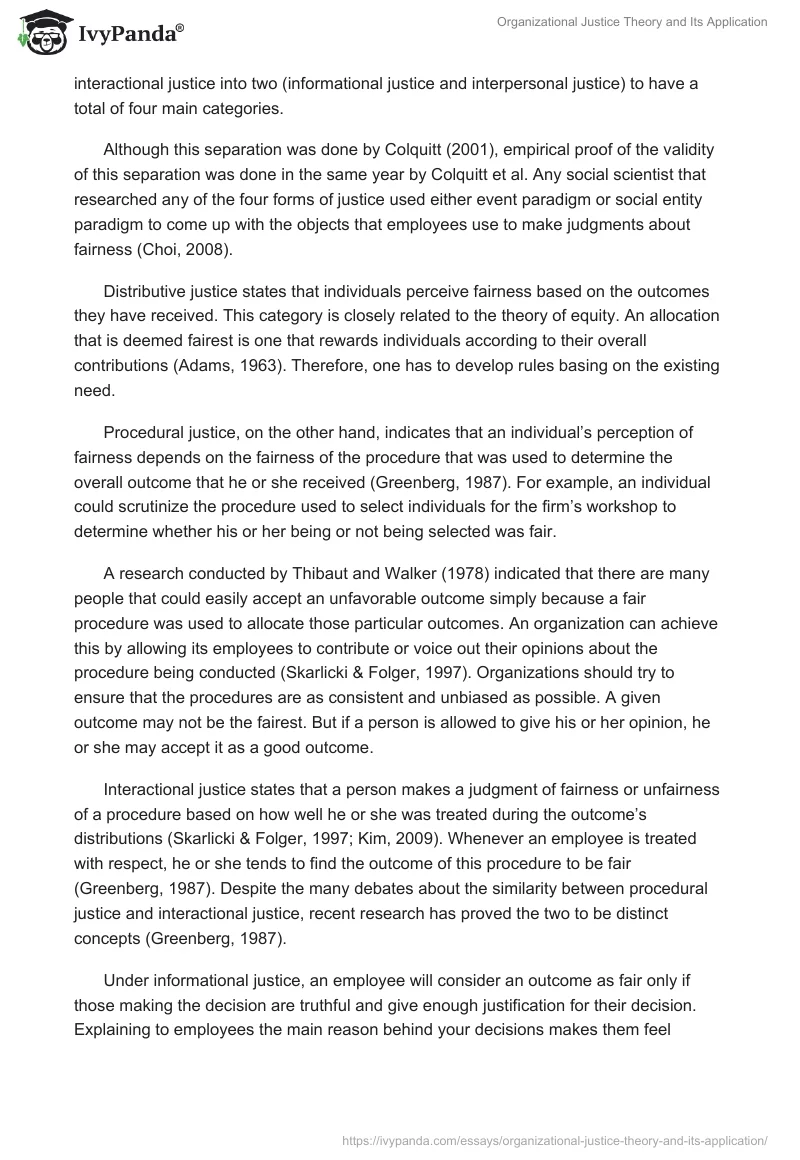Introduction
Organizational justice is all about the way in which individuals or employees of any given establishment judge situations or actions. This theory could be used to solve cases relating to promotions, pay, and supervisor-junior employee relations among other activities in the firm. Regardless of the situation where this theory is applied, it is important to try and strike a balance between successfully applying the organizational justice theory, meeting the organization’s set objectives, and passing the right information to a targeted audience.
Literature Review
Organizational justice can be described as the manner with which employees may perceive behavior, actions, and decision in their organizations, and the way this perception influences their general attitude and behavior at work (Greenberg, 1987). Simply put, it is the way employees perceive fairness as portrayed in the various employment relationships they encounter (Colquitt, Conlon, Wesson, Porter, & Ng, 2001).
Many researchers believe that it is difficult to effectively handle the concept of organizational justice without touching on the equity theory. According to Adams (1963), organizational theory has strong roots in the equity theory. Equity theory states that a person’s judgment of equity or inequity in any situation depends on the comparison between what this person has given (input) and what he or she is getting (output).
In management research, terms such as fairness and justice are usually used interchangeably, because of the many debates by researchers on the many forms of justice that employ the concept of fairness perceptions. Although there are researchers that believe that there are only two types of justice (procedural justice and distributive justice), others add interactional justice to make them three, while the final group divides interactional justice into two (informational justice and interpersonal justice) to have a total of four main categories.
Although this separation was done by Colquitt (2001), empirical proof of the validity of this separation was done in the same year by Colquitt et al. Any social scientist that researched any of the four forms of justice used either event paradigm or social entity paradigm to come up with the objects that employees use to make judgments about fairness (Choi, 2008).
Distributive justice states that individuals perceive fairness based on the outcomes they have received. This category is closely related to the theory of equity. An allocation that is deemed fairest is one that rewards individuals according to their overall contributions (Adams, 1963). Therefore, one has to develop rules basing on the existing need.
Procedural justice, on the other hand, indicates that an individual’s perception of fairness depends on the fairness of the procedure that was used to determine the overall outcome that he or she received (Greenberg, 1987). For example, an individual could scrutinize the procedure used to select individuals for the firm’s workshop to determine whether his or her being or not being selected was fair.
A research conducted by Thibaut and Walker (1978) indicated that there are many people that could easily accept an unfavorable outcome simply because a fair procedure was used to allocate those particular outcomes. An organization can achieve this by allowing its employees to contribute or voice out their opinions about the procedure being conducted (Skarlicki & Folger, 1997). Organizations should try to ensure that the procedures are as consistent and unbiased as possible. A given outcome may not be the fairest. But if a person is allowed to give his or her opinion, he or she may accept it as a good outcome.
Interactional justice states that a person makes a judgment of fairness or unfairness of a procedure based on how well he or she was treated during the outcome’s distributions (Skarlicki & Folger, 1997; Kim, 2009). Whenever an employee is treated with respect, he or she tends to find the outcome of this procedure to be fair (Greenberg, 1987). Despite the many debates about the similarity between procedural justice and interactional justice, recent research has proved the two to be distinct concepts (Greenberg, 1987).
Under informational justice, an employee will consider an outcome as fair only if those making the decision are truthful and give enough justification for their decision. Explaining to employees the main reason behind your decisions makes them feel important (Kim, 2009). Organizations should try to be consistent with telling the truth and giving explanations where necessary.
An organization must always employ the organizational justice theory in its daily activities because employees that feel that fairness is always employed in their organization will feel that their need for control, meaning, belonging, and positive self-regard has been addressed (Cropanzano, Byrne, Bobocel, & Rupp, 2001).
A firm that fully uses the organizational justice theory brings its employees together and makes them proud of it (McShane, Olekalns, & Travaglione, 2013). The feel of fairness in a firm boosts employees’ self-esteem, trust in the firm, interaction level, and ability to work as a team. It also enables them to successfully perform their duties without strict monitoring (Simons & Roberson, 2003).
References
Adams, J. S. (1963). Towards an understanding of inequity. Journal of Abnormal and Social Psychology, 67(1), 422-436.
Choi, J. (2008). Event justice perceptions and employees’ reactions: Perceptions of social entity justice as a moderator. Journal of Applied Psychology, 93(3), 513-528.
Colquitt, J. A. (2001). On the dimensionality of organizational justice: A construct validation of a measure. Journal of Applied Psychology, 86(1), 386–400.
Colquitt, J. A., Conlon, D. E., Wesson, M. J., Porter, C., Ng, K. Y. (2001). Justice at the Millennium: A meta-analytic review of 25 years of organizational justice research. Journal of Applied Psychology, 86(3), 425-445.
Cropanzano, R., Byrne, Z. S., Bobocel, D. R., & Rupp, D. E. (2001). Self-enhancement biases, laboratory experiments, Georg Wilhelm Friedrich Hegel, and the increasingly crowded world of organizational justice. Journal of Vocational Behavior, 58(1), 260-272.
Greenberg, J. (1987). A taxonomy of organizational justice theories. Academy of Management Review 12(1), 9–22.
Kim, H. (2009). Examining the role of informational justice in the wake of downsizing from an organizational relationship management perspective. Journal of Business Ethics, 88(1), 297-312.
McShane, S., Olekalns, M., & Travaglione, T. (2013). Organisational Behaviour : Emerging Knowledge, Global Insights (4th ed.). North Ryde, NSW: McGraw Hill Australia.
Simons, T., & Roberson, Q. (2003). Why managers should care about fairness: The effects of aggregate justice perceptions on organizational outcomes. Journal of Applied Psychology, 88(3), 432-443.
Skarlicki, D. P. & Folger, R. (1997). Retaliation in the workplace: The roles of distributive, procedural, and interactional justice. Journal of Applied Psychology, 82(3), 434-443.
Thibaut, J., & Walker, L. (1978). A theory of procedure. California Law Review, 66(1), 541-566.


